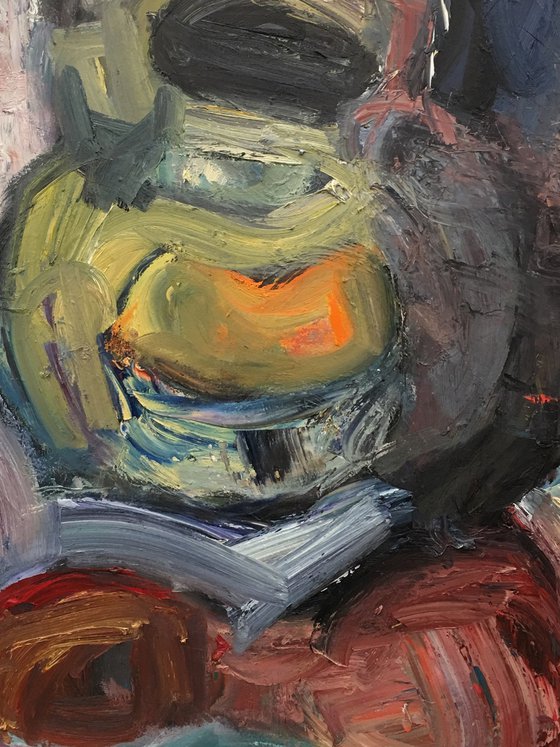- By medium
- By subject
- By budget
- Sales
- Gift cards
- Discover all art
- Artists
- Editors’ picks
- Ideas
Original artwork description:
This heavily applied impasto oil painting, in conjuring likened images of ancient fertility depictions of protective goddesses, is not far off the mark in that regard. It certainly has to do with a woman's fertility and the protective aspect of her love in motherhood. The painting's central figure, simply but fully realized in the form of a large head and torso, anchors the painting in both weight and content. The visage, here protectively enveloped in a gauzy reverential wrap, gazes to our right in an attitude of unhurried contemplation, with her arms gently cradling what might be her breasts or a child at her breast, either reading referring accurately to the aforementioned attributes of love and motherhood. Directly below the woman's torso, as if to form a structural, supporting base is what appears to be her knees in concert with a cross-legged sitting position, but which then morphs tellingly into the head and torso of a second, older child, this one purportedly also under the watchful care of the increasingly plausible mother figure. Left for the eye and imagination to decipher is the vertically positioned blackish apparition-like figure seemingly floating up like so much red-faced smoke to hover near the nurturer/protector's right shoulder. Whether this ghost-like entity is threatening in attitude to our mother figure, or merely on hand to observe or offer watchful matronly guidance, is in the end of no consequence. As any new mother knows (and the rest of us - who have had mothers) can imagine, the overpowering universal instinct of clinging to the love of her children is a natural force of immense and consequential dimensions, and one not to be taken lightly.
Influences, among others, include Max Beckmann, Edvard Munch, Bob Thompson, George McNeil, Richard Diebenkorn, David Park, Francesco Clemente, R.B. Kitaj and Willem de Kooning.
For more information or questions, you can always contact me via Artfinder.
Materials used:
Oil paint, gesso, and charcoal
Tags:
#colorful #expressive #texture #figurative #emotional #emotive #painterly #textural oil paint #movement and energy #motherhood #figurative expressionism #figurative abstract #expressive energetic #dramatic paintings #fertilityCling to Love (1998) Oil painting
by Don Keene
£1,360.17
- Oil painting on Canvas
- One of a kind artwork
- Size: 101.6 x 121.92 x 2.54cm (unframed)
- Ready to hang
- Signed on the front
- Style: Organic
- Subject: Abstract and non-figurative
Loading
Original artwork description
This heavily applied impasto oil painting, in conjuring likened images of ancient fertility depictions of protective goddesses, is not far off the mark in that regard. It certainly has to do with a woman's fertility and the protective aspect of her love in motherhood. The painting's central figure, simply but fully realized in the form of a large head and torso, anchors the painting in both weight and content. The visage, here protectively enveloped in a gauzy reverential wrap, gazes to our right in an attitude of unhurried contemplation, with her arms gently cradling what might be her breasts or a child at her breast, either reading referring accurately to the aforementioned attributes of love and motherhood. Directly below the woman's torso, as if to form a structural, supporting base is what appears to be her knees in concert with a cross-legged sitting position, but which then morphs tellingly into the head and torso of a second, older child, this one purportedly also under the watchful care of the increasingly plausible mother figure. Left for the eye and imagination to decipher is the vertically positioned blackish apparition-like figure seemingly floating up like so much red-faced smoke to hover near the nurturer/protector's right shoulder. Whether this ghost-like entity is threatening in attitude to our mother figure, or merely on hand to observe or offer watchful matronly guidance, is in the end of no consequence. As any new mother knows (and the rest of us - who have had mothers) can imagine, the overpowering universal instinct of clinging to the love of her children is a natural force of immense and consequential dimensions, and one not to be taken lightly.
Influences, among others, include Max Beckmann, Edvard Munch, Bob Thompson, George McNeil, Richard Diebenkorn, David Park, Francesco Clemente, R.B. Kitaj and Willem de Kooning.
For more information or questions, you can always contact me via Artfinder.
Materials used:
Oil paint, gesso, and charcoal
Tags:
#colorful #expressive #texture #figurative #emotional #emotive #painterly #textural oil paint #movement and energy #motherhood #figurative expressionism #figurative abstract #expressive energetic #dramatic paintings #fertility14 day money back guaranteeLearn more


